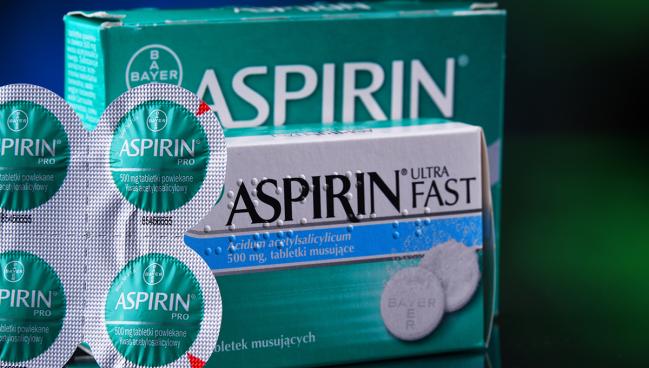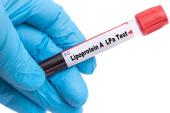Aspirin Use Tied to Slower AAA Progression
Evidence indicates that aspirin not only protects against thrombosis, but also against adverse effects on blood vessels.

Aspirin may be useful for slowing progression of abdominal aortic aneurysm (AAA), a large, retrospective study conducted at a single center suggests.
Patients taking aspirin saw less growth of their aneurysms over several years of follow-up than did those not taking the antiplatelet (mean 2.8 vs 3.8 mm/year; P = 0.001), lead author Essa Hariri, MD (Johns Hopkins Medicine, Baltimore, MD), and colleagues report in a study published online recently in JAMA Network Open.
Aspirin-treated patients also were less likely to have rapid AAA progression, defined as an annual diameter change greater than 0.5 cm/year (adjusted OR 0.64; 95% CI 0.49-0.89).
“Given the myriad of preclinical and clinical data suggesting a role of platelet activation and inhibition in modulating this disease process, randomized clinical data are warranted to ascertain the role of aspirin in managing AAA,” the investigators write.
Senior author Scott Cameron, MD, PhD (Cleveland Clinic, OH), noted that the latest US guidelines on aortic disease contain a class 2b recommendation stating that low-dose aspirin may be considered in patients with AAA and concomitant atheroma and/or penetrating atherosclerotic ulcer. At least some of the justification for such guidance is that aspirin has a protective effect against atherosclerosis and most aneurysms in the infrarenal aorta are atherosclerotic, Cameron said.
But with the combination of preclinical data suggesting that aspirin might have a beneficial impact on AAA progression and risk of rupture and some clinical data supporting an effect on progression, he said, “it may be that you might want to give it not to protect them from a secondary thrombotic event. You might want to give it if they’ve got a small aneurysm.”
Cameron noted that there is evidence that aspirin slows growth of aneurysms in other parts of the body, including the brain, saying he’s not surprised, then, to see a suggestion of a similar effect in the aorta. This study, he said, “may change people’s opinion about starting that medication when the aneurysm is smaller so that it doesn’t progress rapidly.”
An Unmet Need
Evidence from clinical studies has been mixed regarding the impact of aspirin on aneurysm progression and risk of rupture. To explore the impact of aspirin in the setting of AAA further, Hariri et al examined data on 3,435 adults (mean age 73.7; 77.5% men) who had AAA and underwent at least two vascular ultrasounds at Cleveland Clinic between 2010 and 2020; patients with a history of aneurysm repair, dissection, or rupture were excluded. Patients were followed for a median of 4.9 years.
Overall, 62.5% of patients were aspirin users, defined by at least one filled prescription during follow-up. The median duration of use was 10.6 years.
The association between aspirin use and both slower AAA progression and lower odds of rapid progression appeared to be confined to men and nonsmokers, with no significant relationships observed in women or smokers.
Aspirin use was not, however, associated with risks of all-cause mortality (adjusted HR 0.92; 95% CI 0.79-1.07), BARC type 2-5 major bleeding (adjusted HR 0.88; 95% CI 0.76-1.03), or a composite of aneurysm dissection, rupture, or repair (adjusted subhazard ratio 1.16; 95% CI 0.93-1.45).
Cameron said he wasn’t surprised by the association between aspirin and slower AAA progression because similar findings have come from both preclinical and clinical studies, although he was surprised—and disappointed—that there was no apparent impact on incidence of rupture and other outcomes. It could be related, he said, to the fact that patients around Cleveland Clinic are treated aggressively for AAA with surgery and percutaneous interventions, resulting in low numbers of ruptures and other poor outcomes and making it difficult to draw conclusions about the effect of aspirin.
Prior Findings Corroborated
Commenting for TCTMD, Ali Azizzadeh, MD (Smidt Heart Institute at Cedars-Sinai, Los Angeles, CA), also said he wasn’t surprised that aspirin was tied to slower AAA progression. “This corroborates previous findings in smaller studies that perhaps platelets do play a role in aneurysm growth,” he told TCTMD.
What was more of a surprise for Azizzadeh was that there were so many patients in this study who were not on aspirin. He noted that patients with AAA typically have atherosclerotic disease in one or more anatomical beds, saying, “I think patients who have atherosclerotic disease should be on aspirin.”
Azizzadeh said the findings provide a greater impetus to use aspirin in response to an aneurysm and not necessarily in response to concomitant coronary disease. “It adds to the body of literature that supports the use of aspirin for patients with vascular disease,” he said.
Cameron said a patient he might consider putting on aspirin is one who is elderly, has a lot of comorbidities, and is thus at high risk for a surgical aneurysm repair if their AAA were to reach the size threshold to justify the intervention. “So rather than waiting for them to get to the threshold, which is exactly what we do now, if you have a medicine that can prevent growth of that aneurysm, that may be a good thing to consider starting your patients on,” he said, stressing, however, that he wouldn’t endorse that approach without support from a randomized controlled trial.
Todd Neale is the Associate News Editor for TCTMD and a Senior Medical Journalist. He got his start in journalism at …
Read Full BioSources
Hariri E, Matta M, Layoun H, et al. Antiplatelet therapy, abdominal aortic aneurysm progression, and clinical outcomes. JAMA Netw Open. 2023;e2347296.
Disclosures
- Cameron reports receiving an honorarium from VIVA Interventions as faculty lecturing on antiplatelet therapy for vascular disease.
- Hariri reports no relevant conflicts of interest.





Comments